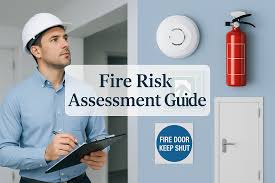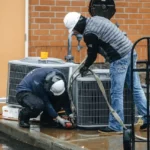Fire risk assessments are critical for ensuring building safety, yet many overlook the hidden danger of asbestos when evaluating fire hazards. Asbestos, once a common construction material, can become lethal when disturbed by fire, renovation, or structural damage. When exposed to intense heat, asbestos-containing materials can release microscopic fibers into the air, posing long-term respiratory risks to anyone nearby. Incorporating asbestos inspections into fire assessments ensures that both immediate fire dangers and latent health threats are addressed simultaneously. This dual-layered approach not only protects lives but also preserves compliance with safety regulations and environmental laws.
Understanding the Connection Between Fire and Asbestos
Fires can cause significant structural damage, often exposing materials that remain undisturbed for decades. In many older buildings, asbestos is found in insulation, ceiling tiles, floor coverings, and wall panels. When flames or heat compromise these materials, asbestos fibers are released into the air, contaminating the entire property. Even after the fire is extinguished, cleanup crews and residents can be exposed to these hazardous particles. Including asbestos testing in fire risk assessments enables proactive detection and management, preventing unnecessary exposure during post-fire recovery. A thorough evaluation considers both the potential ignition sources and the hidden risks embedded in construction materials. Properties in areas with older infrastructure, such as Finchley Road, London, often contain asbestos in building components that may be overlooked during standard inspections. By identifying and managing these risks early, property owners can mitigate long-term health risks and ensure safer emergency response procedures.
Protecting Occupants and First Responders
During a fire, first responders face multiple dangers—heat, smoke, and structural instability among them. When asbestos is present, the threat becomes invisible but equally severe. Inhaling airborne asbestos fibers during firefighting or rescue operations can have devastating consequences over time. Fire risk assessments that include asbestos inspections help safety officers and emergency services plan more effectively. Knowing which areas contain asbestos allows teams to use appropriate protective gear and containment strategies. It also helps guide the cleanup process once the fire is extinguished, ensuring that exposure risks are controlled from the start. Building owners who incorporate asbestos analysis into safety evaluations demonstrate responsibility not only for their tenants but also for the people risking their lives to save others. Protecting occupants and first responders is about foresight—anticipating hidden threats and addressing them before they escalate into irreversible harm.
The Importance of Pre-Incident Planning
A fire risk assessment that includes asbestos testing is not merely a formality—it is a proactive safeguard that strengthens emergency preparedness. Understanding the materials present in a building enables authorities and property owners to create effective evacuation and response plans. For example, if asbestos is found in insulation or ceiling panels, areas can be clearly marked or sealed to prevent exposure during emergencies. Firefighters can then focus on controlling the flames without unnecessarily disturbing contaminated structures. In high-occupancy environments such as schools, hospitals, and office complexes, this knowledge is crucial for protecting vulnerable populations. Pre-incident awareness reduces panic, improves decision-making, and ensures the safety of everyone involved. Proper planning transforms fire assessments from routine procedures into comprehensive safety blueprints that address both visible and hidden hazards. By combining fire prevention strategies with asbestos control, buildings achieve a higher level of preparedness and resilience against emergencies.
Legal and Regulatory Requirements
Incorporating asbestos inspection into fire risk assessments is not only good practice—it aligns with legal obligations under health and safety legislation. Building owners and managers have a duty of care to identify and manage asbestos-containing materials, ensuring they do not pose a risk to occupants or contractors. Many regulations, including the UK’s Control of Asbestos Regulations, require asbestos surveys before any refurbishment, demolition, or maintenance work. Fire risk assessments that fail to address asbestos could be deemed incomplete, potentially exposing property owners to legal penalties. Furthermore, local fire authorities may request documentation proving that all structural hazards, including asbestos, have been properly addressed. Compliance demonstrates that a property owner values both regulatory adherence and human safety. Legal accountability extends beyond prevention—it includes ensuring that the environment remains safe for firefighters, maintenance personnel, and future occupants long after a fire has occurred.
Reducing Long-Term Health and Environmental Damage
When asbestos is released during or after a fire, the contamination can extend beyond the immediate site. Airborne fibers can travel through ventilation systems, settle on surfaces, and even spread outdoors, affecting neighboring properties. Without prior inspection, cleanup efforts may unintentionally disturb contaminated materials, worsening the situation. A fire risk assessment that integrates asbestos testing ensures that appropriate decontamination procedures are followed. This minimizes long-term health risks for anyone involved in restoration and prevents environmental pollution. Asbestos exposure has no immediate symptoms, making prevention the most effective safeguard. By identifying asbestos before a disaster strikes, building owners reduce the risk of widespread contamination and costly remediation. The benefits extend far beyond a single structure—they protect communities, air quality, and public health from invisible harm.
Improving Property Value and Insurance Compliance
Beyond safety and compliance, asbestos inspections can also influence property value and insurance coverage. Properties with documented asbestos management plans are often viewed as lower risk by insurers, leading to smoother policy approvals and potentially reduced premiums. In contrast, unassessed buildings may face higher insurance costs due to unknown hazards. During property transactions, having recent asbestos and fire risk reports provides buyers and investors with confidence in the building’s condition. Transparent documentation ensures smoother negotiations and faster approvals for renovation or occupancy permits. Moreover, insurance companies frequently require proof that safety protocols, including asbestos testing, have been implemented. Integrating both assessments supports full compliance and demonstrates a commitment to maintaining safe, sustainable property standards. Ultimately, addressing asbestos within fire assessments not only safeguards lives but also protects financial investments tied to the property.
Read More: https://acubi.us/why-regular-maintenance-reduces-the-need-for-ac-repair/
Creating Safer Future Building Standards
Combining fire risk and asbestos assessments sets a new standard for building safety management. As construction materials evolve, new regulations are likely to require broader, more integrated safety evaluations. Incorporating asbestos testing now prepares property owners for future compliance and reinforces the importance of a comprehensive safety culture. Educational campaigns and building management systems increasingly emphasize this connection, recognizing that true safety goes beyond visible risks. Every fire risk assessment that includes asbestos analysis contributes to a broader goal: creating safer living and working environments for future generations. It transforms safety from a reactive process into a proactive, ongoing responsibility. Emphasizing both fire prevention and asbestos awareness builds a foundation of trust, commitment, and long-term sustainability across all sectors of construction and property management.
A fire risk assessment that includes an asbestos inspection provides comprehensive protection—addressing both immediate and long-term risks. Fire can uncover or release hidden asbestos fibers, turning a short-lived emergency into a lasting health crisis. Through integrated assessments, homeowners, building managers, and safety authorities can act decisively to prevent exposure and ensure compliance with legal and environmental standards. This proactive approach not only safeguards lives but also protects properties, finances, and communities from preventable harm. The link between fire and asbestos risks is undeniable, and recognizing that connection is key to responsible building management. By combining these assessments, property owners create safer spaces where health, compliance, and peace of mind coexist.



